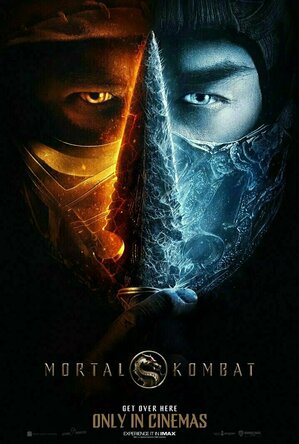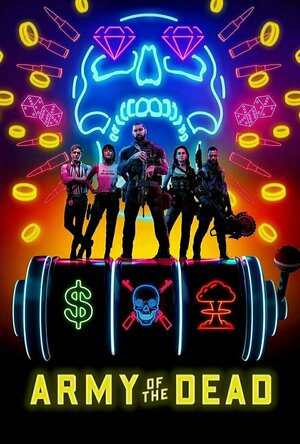Charlie Cobra Reviews (1840 KP) rated Joker (2019) in Movies
Jul 7, 2020
Charlie Cobra Reviews (1840 KP) rated Mortal Kombat (2021) in Movies
Apr 24, 2021
I thought this movie was good. I kind of had high expectations going into it and I can say that in some ways it lived up to the hype and in other ways it didn't. This movie certainly isn't your "daddy's" Mortal Kombat and delivered the goods when it came to blood and gore but I have to say that it was a little more than disappointing when it came to the plot of the movie and how they re-arranged or changed up the storyline. I for one love the opening of the movie that you can see the first 7 minutes of right now everywhere on the internet. How it opens up with the history of the characters Sub-Zero and Scorpion was just awesome. I have to admit that I'm a big Mortal Kombat fan and especially of Scorpion, he's probably my favorite character. So to see the back story to his character done right was just great. I'm still mixed on how I feel about the new kid to the group Cole Young. I mean Lewis Tan did a pretty good job on playing the character in the movie and his action scenes were pretty great too, I guess I'm just not that big a fan of the director throwing in a character into the story that wasn't in any of the games. I also didn't like how they took "poetic license" so to speak with the whole storyline of the franchise and make some rather big changes to the whole Mortal Kombat universe. Like the origin of their powers or even the significance of the whole dragon markings that they have. I will go over in detail all the things that I liked and didn't like in the spoiler section. Although I have my qualms to pick with this film, it was quite enjoyable and I really liked watching it in theaters. That being said though, I think it's worth waiting to see this movie or watch it at home on HBOMax instead of paying more to see it in theaters. I'm at odds on whether to give it my "Must See Seal of Approval" and therefore I don't think that I can but if you are a fan of the old movies or video games then you definitely have to see this movie. I give Mortal Kombat 2021 a 6/10.
-------------------------------------------------------
I had a lot more to say about this movie I. The spoiler section review but it was way too long for Smashbomb so please check out my YouTube video review or check out my full review on my website at
https://cobracharliecr.wixsite.com/charliecobrareviews/post/mortal-kombat-review
BankofMarquis (1832 KP) rated Army of the Dead (2021) in Movies
May 26, 2021
Turns out…plenty.
A pet project of Sndyer’s that has been stuck in “development hell” in Hollywood for almost 2 decades, ARMY OF THE DEAD tells the tale of a group of mercenaries that look to rob $200 million from a vault under the casinos of Las Vegas - one small problem…Las Vegas has been walled off as a way to contain a zombie plague.
My first warning that this was not going to a pleasant experience is that this film has a 2 1/2 hour run time. That certainly seems bloated for a Zombie film and the first 1 1/2 of this flick certainly proves this out as Snyder - ham handedly - seeks to flesh out each of the characters in long, boring exposition scenes that didn’t really add anything to the tension or action. Well…it did add something…restless boredom.
But…I gotta admit, once the group of mercenaries make their way to the vault in Las Vegas, the last hour of the film was pretty darn fun.
Dave Bautista (Drax in the GUARDIANS OF THE GALAXY films) leads the group of mercenaries and Ella Purnell (Emma in MISS PEREGRINE…) is his estranged daughter. I won’t bore you with the details of why these 2 are estranged…but they are and Bautista insists that his daughter NOT come along on this mission. So you know what happens next…yep, she comes along and I was rooting for her to get killed almost from the start. Neither of these 2 characters work and since they are central to the story they are really at the root of the problems with the first 1 1/2 hours of this film.
The rest of the ensemble, however, are a lot of fun and bring that “B Monster Movie” vibe to the proceedings and they look like they are having alot of fun. Tig Notero, Ana de La Reguera, Omari Hardwick and Theo Rossi are an enjoyable lot and know EXACTLY what type of film they are in.
But the standouts of the ensemble are the always great Garret Dillahunt (John Dorie in FEAR THE WALKING DEAD) who brings his usual “A” game to the proceedings. As does Nora Arnezeder (SAFE HOUSE) as “The Coyote” a survivor who has been in Las Vegas before and - especially - Matthias Schweighofer (RESISTANCE) who steals every scene he is in playing the German safecracker.
I would have loved it if Snyder would have cut the Bautista and daughter scenes (and characters) and just had this ensemble go after the loot - it would have been a much better - and shorter - film.
But…if you can last through the long, boring first 1 1/2 hours, the last hour is “good enough” Zombie action with an interesting “twist” on the genre that I will have to give Snyder credit for.
If you do all this, you’ll have a passably decent enough entertaining time.
Letter Grade: B-
6 stars (out of 10) and you can take that to the Bank(OfMarquis)
Bob Mann (459 KP) rated Honest Thief (2020) in Movies
Dec 3, 2020
The nice concept behind the story sees Tom (Liam Neeson) as a hugely successful bank robber meeting the love of his life in Annie (Kate Walsh) and committing to jack it all in for love. Furthermore, not wishing to have to live with the deception and guilt of his hidden life, he determines to hand himself over to the FBI, along with the $9 million stolen cash, in return for a lenient sentence.
There's a problem though: he's about the fifteenth person calling the FBI claiming to be the "In and Out burgler", so no-one wants to take him seriously. Boston area chief Sam Baker (Robert Patrick - the "Terminator" cop!) and his deputy Meyers (Jeffrey Donovan) casually put it on the "to-do" pile of agents Nivens (Jai Courtney) and Hall (Anthony Ramos).
The best laid plans run off the rails in a big way though when Nivens and Hall investigate and find that Tom is the real deal.
The concept here works nicely for a thriller, but the rest of the script is so formulaic that it's fairly and squarely a 'park your brain in the foyer' movie. For several of the actions and motives going on here, suspension of disbelief was required . Even given the limited competition in 2020, the script is in no way going to trouble the Academy.
All that being said, Mark Williams has put together a tight and well-executed movie, not outstaying its welcome at only 99 minutes long. Even with the 15 year age difference, Neeson and Walsh make a believable couple (given that Neeson looks pretty good for his 68 years) and the chemistry between them is great. And for a pretty 'small' movie, the supporting cast is pretty impressive.
Another standout for me was the cinematography by Shelly Johnson (whose had a busy year with the latest "Bill and Ted" and "Greyhound" under his belt). Boston - always a great movie location - looks spectacular, and the framing of the car chase action impressed me.
For me, there was only one really dodgy element of the movie: the special effects used in a house explosion/fire. The budget clearly didn't stretch to using practical effects! More work on Adobe "After Effects" (or similar) was required here!
Is Honest Thief worth seeing? - My expectations for this movie were pretty low. But I'm pleased to say that they were exceeded. Is it a masterpiece? No. Will I readily remember much about it in six month's time? No. But in rather a desert of new releases, this one was at least entertaining and I think it's worth the ticket price for a long overdue night out at the flicks. I'm willing to guess that my feelings were partially influenced by the sheer joy of being back in a cinema again... so I will temper my rating perhaps by a star here.
(For the full graphical review, please check out One Mann's Movies here - https://rb.gy/9kcnr5. Thanks.)
Ivana A. | Diary of Difference (1171 KP) rated Far From Perfect (The Valentines, #2) in Books
Oct 5, 2020
<a href="https://diaryofdifference.com/">Blog</a>; | <a href="https://www.facebook.com/diaryofdifference/">Facebook</a>; | <a href="https://twitter.com/DiaryDifference">Twitter</a>; | <a href="https://www.instagram.com/diaryofdifference/">Instagram</a>; | <a href="https://www.pinterest.co.uk/diaryofdifference/pins/">Pinterest</a>;
#1 <a href="https://www.goodreads.com/review/show/2685992062">Happy Girl Lucky</a> - ★★★★★
#2 <a href="https://www.goodreads.com/review/show/3305103151">Far From Perfect</a> - ★★★★
<img src="https://diaryofdifference.com/wp-content/uploads/2020/08/Book-Review-Banner-74.png"/>;
I am extremely happy and excited to be part of the blog tour for Far From Perfect by Holly Smale. Thank you to the team at Harper Collins and Kaleidoscopic Tours - for letting me part of this tour and sending me a copy of the book.
Far From Perfect is the second book in the Valentines series. Read my review of the first book - Happy Girl Lucky.
<b><i>Synopsis:</i></b>
Being born in a family that is considered Hollywood royalty is not easy. When all her family is expecting perfection form her, Faith just wants to be normal.
Instead, paparazzi follows her everywhere. She needs to rehearse everything she says and does. She needs to be herself - but, you know, someone else... at all times.
<b><i>My Thoughts:</i></b>
Far From Perfect manages to portray an unwanted life in the spotlight of a girl that simply wants to be normal. I was very satisfied to see how the media was presented in this book. They push famous people's boundaries, twist stories and stir waters, causing dramas. And while I understand this is their job, I am grateful to see someone write about the negative impact they have on famous people.
I loved Faith as a character and I was so proud to see her stand up and fight. It was so easy to put myself in her shoes and experience her anger and frustration of not being listened to. I loved the friendship Faith has with Scarlett. It is real and funny and strong. But most of all, I loved the sister bond that Faith has with Mercy. It is so pure and emotional, and it made me think of my own little sister and how much she truly means to me.
The story Faith tells us is a story that will touch every teenager. The struggles of love, family, friendships and finding purpose in the world. We have all been there, we have all fought the same battles and we understand. Even though some problems may seem trivial as a grown up, I remember how important those moments were to me when I was young, and how they shaped me today, and I was glad this was not underestimated in this book.
And sometimes, life makes us forget. Time passes by, and we are lost for a bit. Until a book comes in our hands - to remind us what really matters. This is that book. A beautiful continuation of the series. I recommend it to the teenagers - to find your purpose; and also to everyone else - to remember what that purpose is!
<a href="https://amzn.to/2Wi7amb">Wishlist</a>; | <a
<a href="https://diaryofdifference.com/">Blog</a>; | <a href="https://www.facebook.com/diaryofdifference/">Facebook</a>; | <a href="https://twitter.com/DiaryDifference">Twitter</a>; | <a href="https://www.instagram.com/diaryofdifference/">Instagram</a>; | <a href="https://www.pinterest.co.uk/diaryofdifference/pins/">Pinterest</a>;

Filmmaker Pro
Photo & Video
App
FEATURES - Create and manage unlimited projects - Manage, share / export projects' underlaying...

Video Editor - Videorama
Photo & Video and Entertainment
App
We are proud to present you the most advanced, yet easy to use, video editor and movie maker on the...

Facetune for iPad
Photo & Video and Lifestyle
App
• Limited time sale! Download now and achieve magazine-level photos today! • Facetune is a fun...

Transformers Rescue Bots: Disaster Dash - Hero Run
Entertainment and Education
App
Gather the Rescue Bots, rescue citizens and save the world with epic DinoBots! Budge Studios™...

My Disney Experience
Travel and Lifestyle
App
The official Walt Disney World® app! Now it’s easier than ever to plan and share your vacation...




